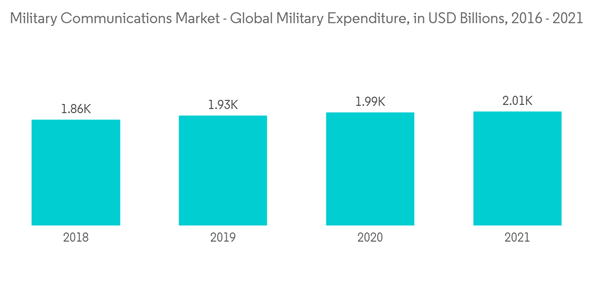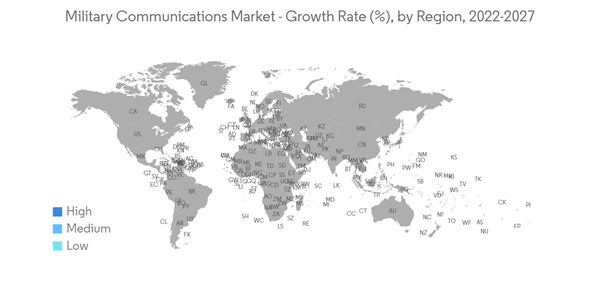The Military Communications Market is expected to witness a CAGR of 4.5% during the forecast period.
Despite the COVID-19 pandemic hitting the global economy severely, the impact of the same was not felt on the global military expenditure, which continued to increase in 2020 and 2021. According to the Stockholm International Peace Research Institute (SIPRI), the global military expenditure reached a total of USD 2.113 trillion in 2021, increasing by about 0.7% compared to 2020. Such high expenditure indicates the negligible impact the COVID-19 pandemic had on defense systems development and procurements.
There is a growing emphasis on increasing investments toward integrating advanced technologies like machine learning and artificial intelligence into communication solutions to enhance military communication. This is also expected to propel market growth in the coming years. The military forces need an advanced communication system for real-time information on the battlefield. The forces also require tactical communication between armed forces and military commanders and allies as communication protocols. The command and control (C2) system use data from the military communications satellites and lines of sight. Furthermore, growing investment in IoT-based communication systems to enhance defense operations drives the growth of the market.
For instance, in January 2022, the South Korean Defense Acquisition Program Administration (DAPA) signed a contract with Hanwha Systems and LIG Nex1 to produce ground-based communication terminals linked to the ANASIS-II, the country’s first dedicated military communications satellite. The total cost of the project is estimated to be USD 742 million between 2021 and 2025. Under the project, the two South Korean companies will develop eight different ground-fixed and vehicle-based communication devices that will operate with the ANASIS-II satellite system. Furthermore, in February 2022, Rafael Advanced Defense Systems signed a contract with the Asian country to install BNET ground communication software defined radio (SDR) on vehicular platforms. Thus, growing procurement of advanced ground-based military communications systems and rising adoption of next-generation communication devices boost the market growth during the forecast period.
In June 2022, the United States Department of Defense announced plans to spend nearly USD 13 billion over the next five years to develop and acquire military communication satellites. This large investment will support growing demands for connectivity and secure data networks for the United States armed forces and national security agencies. The 2023-2027 expenditure plan includes funding for the low Earth orbit broadband constellation and small numbers of communications satellites to augment or replace existing systems. Furthermore, in June 2021, the United States Army tactical network acquisition team requested USD 537 million for the procurement of tactical radios and other commercial communications gear to support the Capability Set 21 fielding.
Additionally, increasing expenditure on the procurement of advanced communication systems and rising spending on the defense sector from the Canadian defense forces propels the market growth. In November 2021, the Canadian Armed Forces (CAF) signed a contract with L3Harris Technologies for the delivery of more than 1,000 compact team radios and related kits. These devices will improve tactical communications for operators on the battlefield and command headquarters. Thus, rising technological advancement and an increase in research and development in satellite connectivity will boost the military communication market across North America.
For instance, in August 2022, BAE Systems unveiled its latest deployable networking product, NetVIPR™, which provides intelligent and secure military communication networks linking everything from small reconnaissance drones to combat vehicles, fighter jets, aircraft carriers, or military commands.
This product will be delivered within 2 business days.
Despite the COVID-19 pandemic hitting the global economy severely, the impact of the same was not felt on the global military expenditure, which continued to increase in 2020 and 2021. According to the Stockholm International Peace Research Institute (SIPRI), the global military expenditure reached a total of USD 2.113 trillion in 2021, increasing by about 0.7% compared to 2020. Such high expenditure indicates the negligible impact the COVID-19 pandemic had on defense systems development and procurements.
There is a growing emphasis on increasing investments toward integrating advanced technologies like machine learning and artificial intelligence into communication solutions to enhance military communication. This is also expected to propel market growth in the coming years. The military forces need an advanced communication system for real-time information on the battlefield. The forces also require tactical communication between armed forces and military commanders and allies as communication protocols. The command and control (C2) system use data from the military communications satellites and lines of sight. Furthermore, growing investment in IoT-based communication systems to enhance defense operations drives the growth of the market.
Military Communications Market Trends
Ground-Based Systems Is Estimated to Show Remarkable Growth During the Forecast Period
In recent years, the world has witnessed political disputes, cross-border issues among neighboring countries, and growing warfare situations that have led to an increased focus on enhancing defense capabilities. The military forces utilized advanced military communications systems for ground-based, air-ground, and shipboard applications. Ground-based systems will witness significant growth during the forecast period. The growth is attributed to the growing use of advanced data links, high-frequency communication systems, and VHF/UHF/L-band systems for ground-based military platforms.For instance, in January 2022, the South Korean Defense Acquisition Program Administration (DAPA) signed a contract with Hanwha Systems and LIG Nex1 to produce ground-based communication terminals linked to the ANASIS-II, the country’s first dedicated military communications satellite. The total cost of the project is estimated to be USD 742 million between 2021 and 2025. Under the project, the two South Korean companies will develop eight different ground-fixed and vehicle-based communication devices that will operate with the ANASIS-II satellite system. Furthermore, in February 2022, Rafael Advanced Defense Systems signed a contract with the Asian country to install BNET ground communication software defined radio (SDR) on vehicular platforms. Thus, growing procurement of advanced ground-based military communications systems and rising adoption of next-generation communication devices boost the market growth during the forecast period.
North America is Expected to Lead the Market During the Forecast Period
North America held the highest market share in military communication systems in 2021, and it is expected to continue its domination during the forecast period. The growth is attributed to the highest defense expenditure, growing focus on improving military communication capabilities, and procurement of next-generation communication devices. The United States was the highest defense spender in the world in 2021.In June 2022, the United States Department of Defense announced plans to spend nearly USD 13 billion over the next five years to develop and acquire military communication satellites. This large investment will support growing demands for connectivity and secure data networks for the United States armed forces and national security agencies. The 2023-2027 expenditure plan includes funding for the low Earth orbit broadband constellation and small numbers of communications satellites to augment or replace existing systems. Furthermore, in June 2021, the United States Army tactical network acquisition team requested USD 537 million for the procurement of tactical radios and other commercial communications gear to support the Capability Set 21 fielding.
Additionally, increasing expenditure on the procurement of advanced communication systems and rising spending on the defense sector from the Canadian defense forces propels the market growth. In November 2021, the Canadian Armed Forces (CAF) signed a contract with L3Harris Technologies for the delivery of more than 1,000 compact team radios and related kits. These devices will improve tactical communications for operators on the battlefield and command headquarters. Thus, rising technological advancement and an increase in research and development in satellite connectivity will boost the military communication market across North America.
Military Communications Market Competitor Analysis
The military communication market is moderately consolidated. The major players operating in this market include Northrop Grumman, Raytheon, General Dynamics, BAE Systems, ASELSAN, Citadel Defense, Fortem Technologies, Airspace Systems, Vantage Robotics, CRON Systems, Rolta, Israel Aerospace Industries, Leonardo, Inmarsat, Viasat, Harris Corporation, and Elbit Systems. With the increase in demand for effective communication systems, major players across the world are investing significantly in technological developments. These are expected to pay off by increasing the market penetration and usage of various products offered by these companies.For instance, in August 2022, BAE Systems unveiled its latest deployable networking product, NetVIPR™, which provides intelligent and secure military communication networks linking everything from small reconnaissance drones to combat vehicles, fighter jets, aircraft carriers, or military commands.
Additional benefits of purchasing the report:
- The market estimate (ME) sheet in Excel format
- 3 months of analyst support
This product will be delivered within 2 business days.
Table of Contents
1 INTRODUCTION
4 MARKET DYNAMICS
5 MARKET SEGMENTATION (Market Size by Value - USD billion)
6 COMPETITIVE LANDSCAPE
Companies Mentioned (Partial List)
A selection of companies mentioned in this report includes, but is not limited to:
- BAE Systems PLC
- Northrop Grumman
- Raytheon Technologies
- General Dynamics
- ASELSAN
- Elbit Systems
- Thales Group
- Israel Aerospace Industries
- Leonardo SpA
- Inmarsat
- L3 Harris Technologies
Methodology

LOADING...










